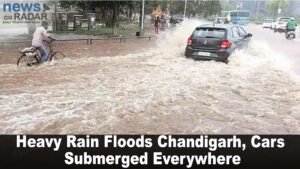Heavy Rain Floods Chandigarh, Cars Submerged Everywhere
PGI Canteen, Nehru Hospital and High Court Parking Severely Affected as Sukhna Lake Floodgates Open…..
Chandigarh , known for its planned structure and green landscapes, witnessed chaos on Tuesday as heavy rainfall lashed the city, leaving several parts waterlogged. The downpour, which continued for several hours, turned many roads into rivers and brought life to a grinding halt. From the parking area of the Punjab and Haryana High Court to the busy corridors of PGI’s canteen and Nehru Hospital, floodwater entered every corner, exposing the city’s fragile drainage system.
lashed the city, leaving several parts waterlogged. The downpour, which continued for several hours, turned many roads into rivers and brought life to a grinding halt. From the parking area of the Punjab and Haryana High Court to the busy corridors of PGI’s canteen and Nehru Hospital, floodwater entered every corner, exposing the city’s fragile drainage system.
The High Court parking area, which usually accommodates hundreds of vehicles, was completely submerged. Cars were seen half-drowned, with water levels reaching above their tires. Owners and officials struggled to move their vehicles out, but the force of water made it almost impossible. The scene highlighted how even well-guarded spaces could not withstand the fury of nature.
In the Postgraduate Institute of Medical Education and Research (PGI), one of the region’s most critical healthcare centers, the canteen turned into a pool. The sudden waterlogging disrupted services, causing inconvenience to staff, patients, and attendants. Similarly, in Nehru Hospital, water seeped inside corridors and waiting areas, making movement for patients and doctors difficult. For people already battling health concerns, the added trouble of navigating floodwater added to the misery.
The rainfall also forced the authorities to open the floodgates of Sukhna Lake to release excess water. This measure, although necessary to prevent overflow, added more pressure to the city’s already waterlogged low-lying areas. Residents in nearby neighborhoods expressed worry, fearing the released water could worsen flooding in their localities.
Commuters bore the brunt of the downpour as vehicles were stuck for hours on waterlogged roads. Major junctions, including Madhya Marg and Sector 17, witnessed traffic snarls stretching for kilometers. People waded through knee-deep water to reach workplaces, schools, and hospitals. Some even abandoned their vehicles midway and chose to walk.
Locals, already familiar with monsoon-related troubles, expressed frustration at the lack of preparedness. Many complained that despite repeated warnings and past incidents, the drainage system remains inadequate. “Every year, the same story repeats itself. The city claims to be modern and well-planned, but a few hours of rain turns it into a flood zone,” said Ramesh Kumar, a resident of Sector 22.
Authorities, however, assured that steps were being taken to address the situation. The Municipal Corporation deployed pumps in several low-lying sectors to flush out accumulated water. Officials also issued advisories urging residents to avoid unnecessary travel and keep vehicles away from flooded areas. Emergency teams were on standby in case the situation worsens.
Despite the challenges, the spirit of Chandigarh’s people shone through. Locals came forward to help stranded commuters, and hospital staff worked tirelessly to ensure patient safety even in knee-deep water. Social media was flooded with videos of submerged cars and overflowing streets, turning the city’s plight into a trending topic nationwide.
The rains brought relief from the heat but also reminded the city of its infrastructural weaknesses. For Chandigarh, a city designed to withstand modern challenges, the floods served as a wake-up call to strengthen its drainage and disaster management systems before nature strikes again.

Comments are closed.